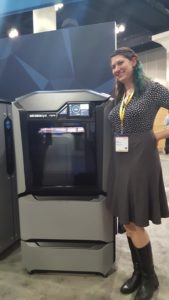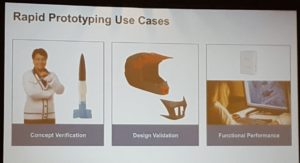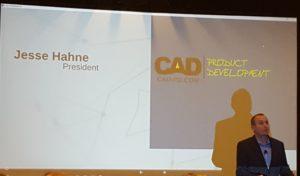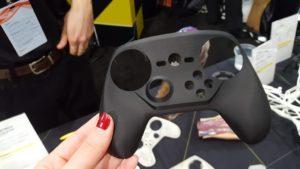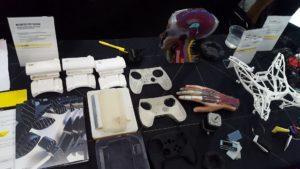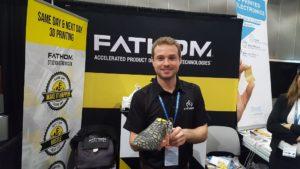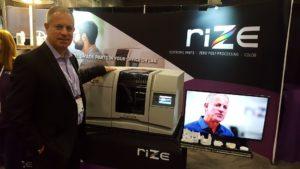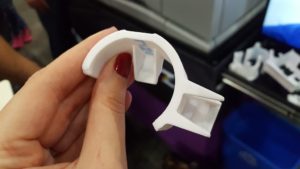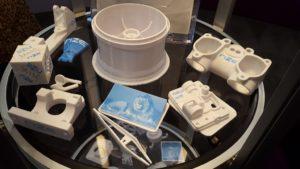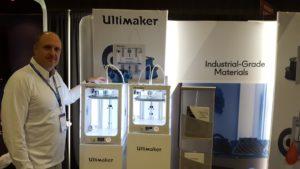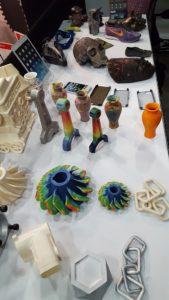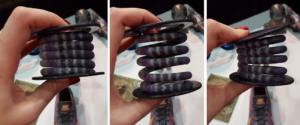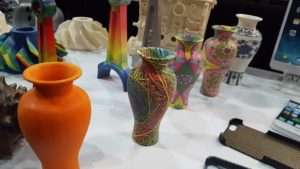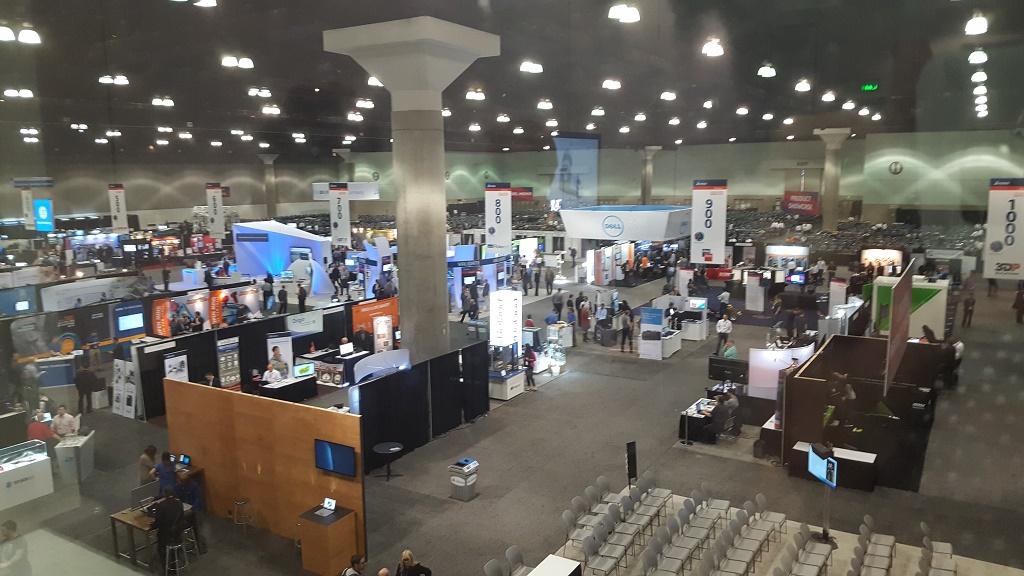 Sometimes a comeback is a great thing; let’s talk about post-2007 Britney, some great moments in sports (that I had to look up), #ThrowbackThursday. Turning back the clock isn’t always a winner (I’m looking at you, JNCO jeans), but in many cases a comeback can bring the focus back to the roots of a project or technology. Following a few years of rapid advances in additive manufacturing technology in which all eyes have been increasingly turned toward end-part production quality, at SOLIDWORKS World 2017 the spotlight was shining squarely on the prototyping market.
Sometimes a comeback is a great thing; let’s talk about post-2007 Britney, some great moments in sports (that I had to look up), #ThrowbackThursday. Turning back the clock isn’t always a winner (I’m looking at you, JNCO jeans), but in many cases a comeback can bring the focus back to the roots of a project or technology. Following a few years of rapid advances in additive manufacturing technology in which all eyes have been increasingly turned toward end-part production quality, at SOLIDWORKS World 2017 the spotlight was shining squarely on the prototyping market.
“We’re coming back to the original purpose in rapid prototyping,” Mark Rushton, Senior Portfolio Management Specialist, Dassault Systèmes, told me at SWW17. “A lot are moving to manufacturing too, like Renishaw, Carbon, and Xometry. Speaking about design for additive manufacturing, we need to optimize for that process. Not until then is it viable to use it for production.”
That “original purpose” for 3D printing has been taking center stage lately, after having been shunted from the limelight in favor of flashier advances in metal AM and the rising trend of going from prototype to production. Prototyping just lost its sheen. Still, as many experts have pointed out, prototyping remains the largest application for 3D printing technologies. The importance of prototyping to the product development cycle cannot be overstated, and 3D printing presents an invaluable tool for speeding the time to market. It may not be the sexiest application out there, but it is the foundational cornerstone of the AM industry. At SWW17 this week, rapid prototyping came roaring back to attention, as 3D design and 3D printing bring products to life in speedier, more efficient, and increasingly higher quality than ever before.
Obviously the big announcement at SWW17 was the introduction of Stratasys’ F123 Series solution, intended to be a “game-changer” for rapid prototyping. Stratasys, which also announced an AM-focused partnership with Dassault Systèmes, is bullish about the F170, F270, and F370 3D printers’ potential to reshape rapid prototyping.
“Rapid prototyping may have been the first port of call in 3D printing, but there’s still room for growth,” Tim Bohling, Stratasys’ Chief Marketing Officer, told us at the the press conference. “This is a full prototyping solution: hardware, services, and software.”
Rich Garrity, President, Americas, at Stratasys, built on this: “We believe rapid prototyping still represents a significant opportunity for additive manufacturing… We found that our customers are demanding a one-stop shop for rapid prototyping.”
When I sat down the next day with Stratasys’ Patrick Carey, Senior Vice President, Sales, and Roger Kelesoglu, Director, Sales Enablement, the pair noted that while Stratasys sees itself as the leader in 3D printing prototyping, most prototyping is still done with traditional, rather than AM, methods.
“Wow, Stratasys is talking about prototyping again,” Carey said with a laugh. “But why isn’t prototyping growing beyond that 25 percent of the market? Our focus is on offering a solution. Manufacturing is built on top of prototyping. And if we grow prototyping, we will grow use in manufacturing as we talked about at IMTS.”
- The Stratasys press conference at SWW17
Keeping the focus more on the intended goal — fast, accurate, low-cost prototypes created safely and accurately — this solution is set to speed up prototyping timelines while cutting costs; Carey estimates that new prints can be created 25% faster than on their older Dimension models, while Kelesoglu pointed out that using the Fast Draft PLA mode, prints can be made up to five times faster while being up to ten times less expensive, calling it a “game-changer for volume.” (“Game-changer” was the phrase of choice for Stratasys throughout the event.) Carey told me that “The response to our announcement has been phenomenal,” and it didn’t seem like much of an exaggeration; the F123 Series have already logged more than 90,000 testing hours. Some feedback we’ve received already includes:
“The easy material changeover is a game-changer for us” — Jesse Hahne, President, Center for Advanced Design, a beta customer, at the press conference.
“After two years of research and development, Stratasys has delivered a truly compelling offering here. It’s an exciting development, and one in which Laser Lines has been involved since the beginning. Stratasys asked us what we and our customers wanted to see in its next generation products and it’s come up with is the perfect fit” — Mark Tyrtania, Sales Director, Laser Lines.
“A key complaint in the past was the inability to print at 5 thousandths of an inch, and lack of access to materials besides ABS. These issues have been addressed giving you ASA and PLA in addition to ABS. Furthermore, The 370 gives you access to PC-ABS, which offers more toughness, flexibility, and one of the highest impact resistance of all 3D printed plastics” — Cimquest.
I also spoke with FATHOM at SWW, which houses an F370 unit at its Seattle office. I checked out a video game controller shell 3D printed on the system, and the resolution was indeed pretty impressive. The physical footprint of the machine is also pretty compact, which is nice to see in a unit with a relatively sizable build volume.
While Stratasys took the mic, as it were, regarding rapid prototyping, they were by no means the only ones talking up this often-overshadowed aspect of the industry. Indeed, several of the designs FATHOM was showing off were excellent examples of 3D printed prototypes.
- FATHOM’s 3D printed controller shell, created on the Stratasys F370
Frank Marangell, President and CEO of Rize, told me that post-processing is often regarded as a hidden cost-factor that “no one talks about” in the industry; their Rize One 3D printer was designed with the intent to speed processes along by cutting post-processing time almost completely out of the equation. He handed me a part 3D printed on the Rize One, complete with raft and supports, and asked me to clean it up as we stood talking. Even with jittery coffee hands (it was early), it took me maybe 30 seconds to remove the excess materials from the piece and toss them into the recycling bin nearby. Further saving time, the Rize One was designed to be able to print an imperfect CAD file, cutting the need for software like Magics or netfabb, and is able to print right from SOLIDWORKS. One customer Rize has been working with has told them that use of the Rize One will save them $23 million in iterations alone as they work toward new product development. The Rize One can also be used for end-use parts — Marangell told me they see their place in the market as somewhere in the middle, between prototyping and low-volume manufacturing — for custom one-offs, “where 3D printing is most valuable.” The Rize One became publicly available this month.
- Frank Marangell
- The supports snapped very cleanly off
Staying on the desktop, John Kawola, North American President, Ultimaker, has been paying closer attention lately to the professional market, where the Ultimaker 3 in particular is valued for its recently introduced features such as dual extrusion. While the company is “getting pulled into the conversation about manufacturing applications,” prototyping remains an area of focus for professional users, as Kawola has told us previously.
Ireland’s Mcor has been making a big splash with the impending release of their ARKe 3D printer which, as Tom Poudrier, Sales Manager, Americas, told me, is very well suited for rapid prototyping, among other applications. The full-color capabilities of the machine offers versatility on the desktop, including flexible prints created with paper. As an example of a prototyping application, Poudrier picked up a small 3D printed vase. It was orange. Violently orange. He said they might show that to Pier One as an example of a vase for the store, but that if the customer rejoined that they liked the shape, but couldn’t stand seeing it in orange, and could it perhaps be bigger, the ARKe could quickly create a larger-sized vase with a full-color pattern, then a larger size still to better show the shape — and finally an even larger one in a more traditional pattern to showcase what the customer might actually be looking for in a vase. And of course, all of this could be done in a fraction of the time of subtractive methods.
Of course many of the other 3D printing companies present at SWW17 — including German RepRap, Carbon, HP, 3D Systems, BCN, MatterHackers, Markforged, Formlabs, Airwolf3D, and others — hosted further examples of prototyping potential made possible with 3D printing as well. SWW17 was not the biggest show I’ve attended even in 2017, but was a hotbed of ideas and activity as attendees all had great experience in and realistic expectations for what technology can do — and what 3D design can make possible.
Rapid prototyping remains a cornerstone of the 3D printing industry, and in a way it’s quite nice to see it coming back into focus. New technologies on the AM block have their choice of target applications for their own software and hardware introductions. It’s reassuring to see that many of the areas of R&D are not ignoring prototyping applications, and that companies like Freight Farms, which was on hand with their shipping container-cum-urban garden system, are more open to sharing just how 3D technologies led them to successful market entry through design and rapid prototyping. Discuss in the Rapid Prototyping forum at 3DPB.com.
[All photos taken on-site at SWW17 by Sarah Goehrke for 3DPrint.com]
Subscribe to Our Email Newsletter
Stay up-to-date on all the latest news from the 3D printing industry and receive information and offers from third party vendors.
You May Also Like
3D Printing Unpeeled: New Arkema Material for HP, Saddle and Macro MEMS
A new Arkema material for MJF is said to reduce costs per part by up to 25% and have an 85% reusability ratio. HP 3D HR PA 12 S has been...
3D Printing News Briefs, January 20, 2024: FDM, LPBF, Underwater 3D Printer, Racing, & More
We’re starting off with a process certification in today’s 3D Printing News Briefs, and then moving on to research about solute trapping, laser powder bed fusion, and then moving on...
3D Printing Webinar and Event Roundup: December 3, 2023
We’ve got plenty of events and webinars coming up for you this week! Quickparts is having a Manufacturing Roadshow, America Makes is holding a Member Town Hall, Stratafest makes two...
Formnext 2023 Day Three: Slam Dunk
I’m high—high on trade show. I’ve met numerous new faces and reconnected with old friends, creating an absolutely wonderful atmosphere. The excitement is palpable over several emerging developments. The high...



